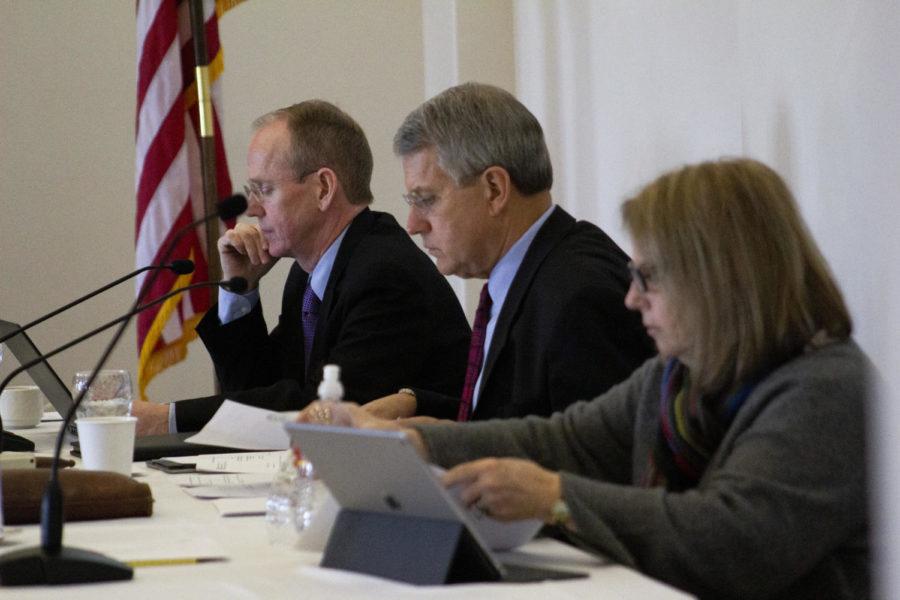Editorial: There is still time to invest in higher education, Iowa Legisalture
Kennedy DeRaedt/Iowa State Daily
John Nash (left), Regent Milt Dakovich (middle) and Regent Patty Cownie (right) listen to the Property and Facilities Committee. The Board of Regents held a meeting Feb. 27, 2019, in the Reiman Ballroom at the Alumni Center.
April 16, 2019
Iowa Legislature, you still have time to make the right decision.
Currently, the Iowa Board of Regents is stalling on its decision to do a first reading on an undergraduate tuition increase because the House and Senate have failed to pass their higher education budget.
The Regents made it clear in November that its tuition decisions will be based on state appropriations. In years past, tuition increases had been introduced and approved before the state approved its budget, which in some respects gave the state a free pass to underfund the Board of Regents because they knew a tuition increase was on the horizon regardless of their decision.
And while this year is similar — with the Regents outlining three separate tuition proposals — the onus now falls on the Legislature to take a proactive role in the budget negotiations.
According to the Regents budget proposals, if the state fully funds the Regents’ request of $499 million, base resident tuition rates will increase by 3 percent. If the state chooses to partially fund the Regents’ request, base resident tuition rates may increase by as high as 5 percent.
In Gov. Kim Reynold’s budget recommendations to the Legislature, she matched the Regents’ request, which included an additional $18 million more than the budget approved for the current fiscal year.
However, the Iowa House passed a bill only partially funding the Regents’ request, as it falls $2.1 million short of the governor’s recommendations.
The Iowa Senate has also passed separate funding legislation, which offers $14 million less in education funding than the House bill. It has not been determined yet, however, how much of the budget is dedicated solely to higher education.
This is not a new trend. In just the past two fiscal years, the Legislature has made $35 million in midyear cuts to the Board of Regents. Top that with consecutive rising tuition costs, as well as growing enrollment at Iowa universities, and there’s just not enough money to go around.
But by continuously failing to fund higher education, the Iowa Legislature is choosing to ignore the necessary role that its universities play in growing the economic development of this state.
While it is true that many students attend Iowa State because the university has a program that meets their needs, many students also attend because it is affordable.
It costs a lot to be a student. Not only do they have to pay for tuition, but also housing and food and the many other necessities that it takes to live. And even if a student works their way to school, a 20-hour per week minimum wage job would gross $7,540 per year.
To be a full-time resident undergraduate costs $7,740.
It’s not impossible to be a student, but rising tuition costs matched with a lagging investment in higher education will make it so.
There’s going to be a tuition increase for resident students no matter what, but the Legislature still has the opportunity to alleviate the growing costs.

















